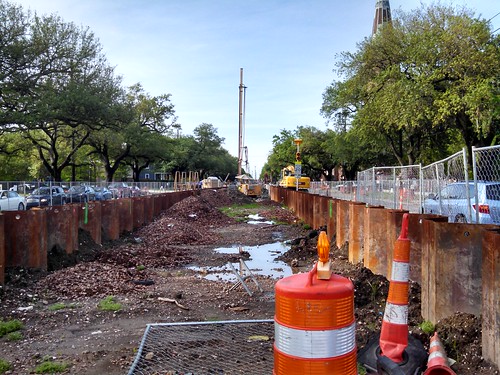That seems very dramatic but it's actually pretty routine for springtime. Every now and then it gets particularly bad and everyone decides something needs to be done about it. The last time that happened was 20 years ago. In reaction to the famous "May flood" the Army Corps of Engineers was persuaded to begin an ambitious drainage improvement project. They still haven't finished it.
Here they are digging a new culvert on Napoleon Avenue just yesterday.

But simply digging a bigger drainage ditch may not be solving the problem. It could, in fact, be making it worse.
Locals may celebrate that efficiency, but Roelof Stuurman, a visiting Dutch groundwater specialist, shakes his head in disgust when he thinks of that rapid and regular wet-to-dry cycle in New Orleans.The "Living With Water" plan involves a potential $9 billion worth of additional projects designed to stabilize the water table.. to some extent anyway.
“You spend your money trying to get every last drop of water out of your city when you should be trying to keep some of it in,” Stuurman said. “You have this serious problem, and no one is in charge of it. Instead, you’re making it worse.”
That problem is subsidence — the steady, costly and dangerous sinking of the city caused by the drying of the delta soils on which it rests. It turns out that New Orleans, known for its epic battles to keep water outside of its levees, is also threatened by keeping too little water in.
A city that prides itself on embracing contradiction is now waking up to this one: The levees and pumping stations it has spent nearly 300 years perfecting to guard against external threats have also been the catalysts allowing an unseen enemy below to savage its budgets and cloud its future.
“When we settled here, the land under us was like a sponge that contained a lot of water,” said David Waggonner, a landscape architect and co-author of the Greater New Orleans Urban Water Plan, which aims to change the city’s relationship with water. “And what happens to a sponge when you dry it out? It shrinks.
It proposes doing that not only by keeping water inside the levees, but actually by showing it off.Keep in mind, that this isn't going to solve our problem. The city is sinking and will continue to sink. But maybe we can do some stuff to help it sink less rapidly. But first we have to finish digging these ditches.
The 82 miles of open drainage canals that form concrete scars across the cityscape when empty would become manicured bayous lined with recreation paths and holding water all year long. Empty lots left by Katrina that now collect only weeds and debris would become rain gardens — temporary reservoirs that can reduce the speed and amount of water rushing toward the pumps during heavy downpours.
But the change would be more than skin-deep. Streets and parking lots would be surfaced with materials that allow water to seep into the soils below. Homes and buildings would have rain barrels that trap runoff from roof gutters, then let it out slowly over time. New developments would need to have stormwater management plans to account for their impacts on the system.
Update: Hey look the water management plan that only exists in your imagination right now has won some kind of recognition.
New Orleans' strategy for redesigning the urban landscape to better manage its water resources -- better known as the Greater New Orleans Urban Water Plan -- is being recognized as a model for the rest of the country to follow.Hey congratulations, you guys have made zero actual impact. This will look great on a resume, though.
The American Planning Association will present the city with its Environmental Planning Award at its April 18 conference in Seattle. The honor is given to cities that work to "create greener communities that reduce the impact of development on the natural environment and improve the environmental quality."
No comments:
Post a Comment